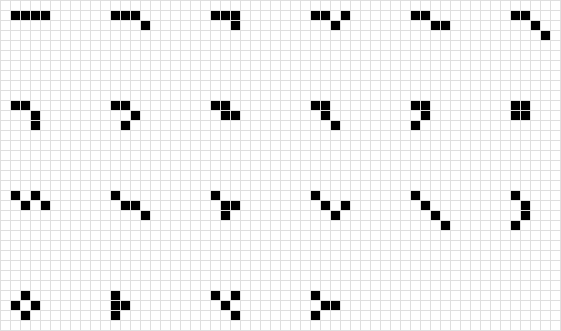Polyplet
A polyplet (or simply a plet) is a finite collection of orthogonally or diagonally connected cells. The form of connectivity allowed by polyplets is sometimes called king-wise connectivity because of the way a king moves on a chess board. King-wise connectivity is a more natural concept in Life-like cellular automata than the orthogonal connectivity of polyominoes.
Sizes of polyplets
Polyplets with n cells for n = 3, 4, 5, ... are called triplets, tetraplets, pentaplets, hexaplets, heptaplets, and n-plets in general. The number of distinct polyplets with n cells for n = 1, 2, 3, ... is given by the sequence 1, 2, 5, 22, 94, 524, 3031, 18770, 118133, ... (Sloane's ![]()
Triplets
There are exactly five distinct triplets, shown below. The first two are the two triominoes (pre-block and blinker), and the other three vanish after two generations (being the banana spark, V spark and a fuse of length 3 respectively).
Download RLE: click here
Tetraplets
Of the 22 distinct tetraplets:
- 5 vanish
- 9 into blocks
- 1 is the block itself
- 4 become a block in 1 generation
- 4 become a pre-block in 1 generation
- 4 into beehives
- 1 into a pond
- 1 is the tub
- 2 into alternate phases of the traffic light
- 1 is the T-tetromino
- 1 is a parent of the T-tetromino

Download RLE: click here
Pentaplets
The 94 distinct pentaplets evolve as follows:
- 39 into nothing
- 11 into loaves
- 10 into traffic lights
- 6 in the phase with "+" on even generations
- 4 in the phase with "o" on even generations
- 9 into beehives
- 7 into boats (including the boat itself)
- 4 into blocks
- 4 into gliders (including the two that are themselves phases of the glider)
- 3 into ponds
- 2 into tubs
- 1 into the pi heptomino (after two generations; the first generation evolution is the "<" hexomino)
The remaining four are or become the R-pentomino:
- one is the R-pentomino itself
- one becomes the R-pentomino after one generation
- two become the aforementioned pentaplet after one generation (and thus become the R-pentomino after two).